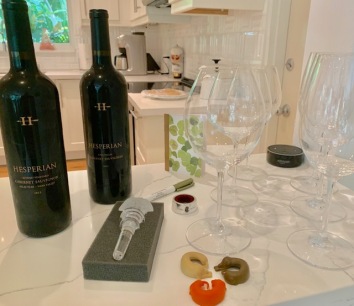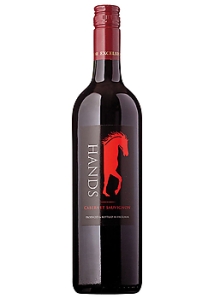 Two college friends on the phone being silly and excited about a new wine: “Life is a Cabernet old chum, life is a Cabernet“. So began the story behind this review. A play on song lyrics from days before our time. But we won’t go there.
Two college friends on the phone being silly and excited about a new wine: “Life is a Cabernet old chum, life is a Cabernet“. So began the story behind this review. A play on song lyrics from days before our time. But we won’t go there.
Celebration was in the air. Friends overdue for a wine-tasting and the news that Whine and Cheers for Wine had cracked the TOP 100 WINE BLOGS by Feedspot: Best 100 Wine Blogs, Websites And Newsletters To Follow in 2019. 
The stage set; wine glasses, note pads, decanters, Coravin, glass identifiers etc. We were even ready for possible pairings; cheeses, charcuterie, nuts, and chocolates along with water crackers for palate cleansing. I say “possible” pairings because as I told the parties involved: “this is all about the wine”. We may pair, we may not. Eventually we did, but not before spending a long time getting to know the wines individually and comparatively. 

Hesperian Wines come with quite the pedigree thanks to winemaker Philippe Langner and his hands-on experiences from Bordeaux to South Africa and now California with a Rothschild influence here or there.
From Hesperian Wines:
California’s persistent call is an inspiration for the name for his domaine. Hesperian, or “One of The West,” is a name that invokes the mythical garden of Hesperides, a blissful twilight orchard in the west where Hercules once tricked Atlas into helping him complete his eleventh labor.Today Philippe has chosen to make his home and his life’s work in one place: a steep, rocky, 14-acre vineyard named “Kitoko”, the Congolese Lingala word for “beautiful.” This is the place he has chosen to fulfill his vision, combining his exacting knowledge of viticulture and his constant quest for precision—indeed perfection—in winemaking.

As some of my Whine and Cheers followers may know, I prefer to know as little as possible about a wine prior to a private tasting. In a way I enjoy the discovery aspect of the relationship we are about to build. With the history or backstory hopefully sealing the deal. Leaving me wanting more and looking forward to a second date.
Hearing myself as I write about my passion and the romance behind it I have come to realize that there are wines you date and wines you marry. I have now learned: Hesperian Wines are the marrying kind.
Two wines. Both from Hesperian and wine-maker Philippe Lagner, both 100% Cabernet Sauvignon, and both from the 2015 vintage. Available through their web-site and via Club Membership. How do the wines differ? The Hesperian Napa Valley ($100) was created by combining wines (50/50) from Coombsville and Kitoko Vineyard on Atlas Peak. The Hesperian Kitoko Vineyard ($150) is sourced entirely from the fourteen acre Kitoko Vineyard. Only 300 cases of each were produced.
-Hesperian Napa Valley notes;
Bold nose with new wood [oak] at forefront and a dark fruit background. In addition on the palate our descriptors included; spices (black pepper), leather (even more so on the second pour), forest floor mossiness. This smooth, balanced, structured, elegant wine was all old-world style and the farthest from a fruit bomb a California wine could be.
Vintner notes: 2015 Hesperian Cabernet Sauvignon ~ Napa Valley
-Our Hesperian Kitoko Vineyard notes:
A softer/demure nose when compared to the Napa Valley above. New wood (oak) at the forefront with red fruit compote in background. In addition on the palate; chocolate, lilac, a peaty earthiness, concentrated dry fruit (fig), anise. This single vineyard wine came across as smoother, more delicate yet wilder. It was incredible to see it develop and come to life in a 20 minute time-span.
Vintner notes: 2015 Hesperian Cabernet Sauvignon Kitoko Vineyard ~ Napa Valley
As you can probably tell by my accolades thus far, these wines were both big hits. Each had its own character and yet some similarities and both can easily age for ten plus years for the collectors out there. The 100% Kitoko Vineyard wine seemed more focused and wilder while the Hesperian Napa Valley came across as bold, rounder with more nuances. Probably due to the blend of the two vineyards; Kitoko and Coombsville. We found both to be inspiring in their own way and considered ourselves lucky to not have to choose between them. Each of these old-world style wines took you on a journey that you did not want to end.
As per Hesperian Wines web-site: Philippe lives and works at Kitoko Vineyard on Atlas Peak, and continues to consult on viticulture and winemaking matters for select Napa Valley wineries. I find myself now looking forward to trying other vintages, previous and future, from Hesperian Wines and other wines produced by Philippe Langner.
How refreshing it is to have this kind of wine coming out of Napa Valley. How lucky are we to have someone of this caliber focused on celebrating the worthiness of individual varietals the way they were meant to be experienced. In this case, Life IS a Cabernet!
¡SALUD!
Additional notes from Hesperian Wines:
Vintage 2017 Outlook
March 31st, 2019
The 2017s were blended in February and put back to barrel. It takes a while for the various lots that went intothe three blends to really integrate well. The wines are coming along nicely. Get ready for very big wines with the ‘17s. This was the vintage of the fire, and I’m very happy and relieved to report that there is no smoke taint in the wines. (I’ve had others smell and taste Hesperian’s ‘17s, and they tell me the same. Relief!)
The 2018s are fantastic, perhaps the best wines I’ve made so far. We are almost done with the first racking; some wines were starting to reduce a bit and they needed some air. Alas, we have to be patient. We won’t see these wines coming available until 2021.
Disclosure: media sample; all thoughts & opinions included in this post/ review are my own.




